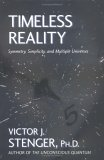In his exciting new book, physicist Victor J. Stenger shows how time
symmetry at the quantum level makes it possible to draw a model of underlying
reality that is simpler and more symmetric than the conventional view.
This reality is timeless, with no beginning, no end, and no arrow of time.
Time is indeed reversible. And in this “timeless reality,” nothing rules
out the existence of other universes besides our own; in fact, such a multiverse
is strongly suggested by modern theories of cosmology. But whether or not
reality has one universe or many, it had no beginning and was not created.
It neither was nor will be. It just is.
From the Inside Flap:
Quantum physics has many extraordinary implications. One of the most extraordinary is that events at the atomic and subatomic level seem to
depend on the future as well as the past. Is time really reversible?
Physicist Victor J. Stenger says yes. Contrary to our most basic assumptions
about the inevitable flow of time from past to future, the underlying reality
of all phenomena may have no beginning and no end, and not be governed
by an “arrow of time.” Though aware of the possibility, physicists have
generally been reluctant to accept the reversibility of time as reality
because of the implied causal paradoxes: If time travel to the past were
possible, then you could go back and kill your grandfather before he met
your grandmother! However, Stenger shows that this paradox does not apply
for quantum phenomena.
Many people believe that the laws of nature represent a deep, Platonic
reality that goes beyond the material objects that are observed by eye
and by advanced scientific instruments. Stenger maintains that reality
may be simpler and less mysterious than most think. The quantum world only
appears mysterious when forced to obey rules of everyday human experience.
Stenger convincingly argues that, based on established principles of simplicity
and symmetry, at its deepest level reality is literally timeless. Within
this reality it is possible that many universes exist, each with structures
and laws different from our own.
Using language that is easily understood by the nonspecialist, Stenger
elucidates these complex subjects with astounding clarity. The many vivid
illustrations also help make the book come alive in a manner that is more
accessible to the educated lay reader.




